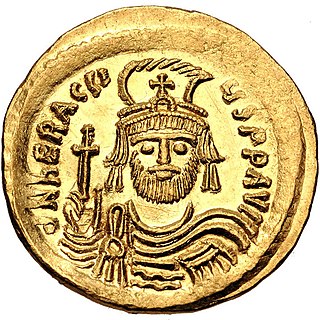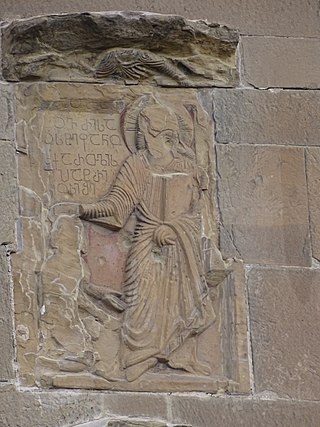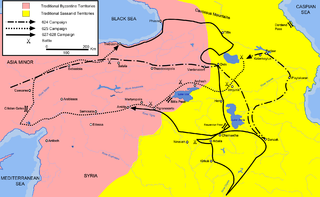
Heraclius was Byzantine emperor from 610 to 641. His rise to power began in 608, when he and his father, Heraclius the Elder, the Exarch of Africa, led a revolt against the unpopular emperor Phocas.
The 620s decade ran from January 1, 620, to December 31, 629.

Year 627 (DCXXVII) was a common year starting on Thursday of the Julian calendar. The denomination 627 for this year has been used since the early medieval period, when the Anno Domini calendar era became the prevalent method in Europe for naming years.

Year 628 (DCXXVIII) was a leap year starting on Friday of the Julian calendar. The denomination 628 for this year has been used since the early medieval period, when the Anno Domini calendar era became the prevalent method in Europe for naming years.

The Battle of Nineveh was the climactic battle of the Byzantine–Sasanian War of 602–628.

Shahrbaraz, was shah (king) of the Sasanian Empire from 27 April 630 to 9 June 630. He usurped the throne from Ardashir III, and was killed by Iranian nobles after forty days. Before usurping the Sasanian throne he was a spahbed (general) under Khosrow II (590–628). He is furthermore noted for his important role during the climactic Byzantine–Sasanian War of 602–628, and the events that followed afterwards.

In Greco-Roman geography, Iberia was an exonym for the Georgian kingdom of Kartli, known after its core province, which during Classical Antiquity and the Early Middle Ages was a significant monarchy in the Caucasus, either as an independent state or as a dependent of larger empires, notably the Sassanid and Roman empires. Iberia, centered on present-day Eastern Georgia, was bordered by Colchis in the west, Caucasian Albania in the east and Armenia in the south.
Rhahzadh, originally Roch Vehan, known in Byzantine sources as Rhazates was a Sasanian general of Armenian origin under Shah Khosrow II.
Shahen or Shahin was a senior Sasanian general (spahbed) during the reign of Khosrow II (590–628). He was a member of the House of Spandiyadh.
The Perso-Turkic war of 627–629 was the third and final conflict between the Sasanian Empire and the Western Turkic Khaganate. Unlike the previous two wars, it was not fought in Central Asia, but in Transcaucasia. Hostilities were initiated in 627 AD by Tong Yabghu Qaghan of the Western Göktürks and Emperor Heraclius of the Byzantine Empire. Opposing them were the Sassanid Persians, allied with the Avars. The war was fought against the background of the last Byzantine-Sassanid War and served as a prelude to the dramatic events that changed the balance of powers in the Middle East for centuries to come.

The Chosroid dynasty, also known as the Iberian Mihranids, were a dynasty of the kings and later the presiding princes of the early Georgian state of Iberia from the 4th to the 9th centuries. The family, of Iranian Mihranid origin, accepted Christianity as their official religion c. 337, and maneuvered between the Byzantine Empire and Sassanid Iran to retain a degree of independence. After the abolition of the Iberian kingship by the Sassanids c. 580, the dynasty survived in its two closely related, but sometimes competing princely branches—the elder Chosroid and the younger Guaramid—down to the early ninth century when they were succeeded by the Georgian Bagratids on the throne of Iberia.

The siege of Constantinople in 626 by the Sassanid Persians and Avars, aided by large numbers of allied Slavs, ended in a strategic victory for the Byzantines. The failure of the siege saved the empire from collapse, and, combined with other victories achieved by Emperor Heraclius the previous year and in 627, enabled Byzantium to regain its territories and end the destructive Roman–Persian Wars by enforcing a treaty with borders status quo c. 590.

Stephen I, of the Guaramid Dynasty, was a presiding prince of Iberia from c. 590 to 627. He was killed after Siege of Tbilisi by the invading Byzantine army.
The First Turkic Khaganate, also referred to as the First Turkic Empire, the Turkic Khaganate or the Göktürk Khaganate, was a Turkic khaganate established by the Ashina clan of the Göktürks in medieval Inner Asia under the leadership of Bumin Qaghan and his brother Istämi. The First Turkic Khaganate succeeded the Rouran Khaganate as the hegemonic power of the Mongolian Plateau and rapidly expanded their territories in Central Asia. The khaganate became the first Central Asian transcontinental empire from Manchuria to the Black Sea.

The Byzantine–Sasanian War of 602–628 was the final and most devastating of the series of wars fought between the Byzantine Empire and the Persian Sasanian Empire. The previous war between the two powers had ended in 591 after Emperor Maurice helped the Sasanian king Khosrow II regain his throne. In 602, Maurice was murdered by his political rival Phocas. Khosrow declared war, ostensibly to avenge the death of the deposed emperor Maurice. This became a decades-long conflict, the longest war in the series, and was fought throughout the Middle East: in Egypt, the Levant, Mesopotamia, the Caucasus, Anatolia, Armenia, the Aegean Sea and before the walls of Constantinople itself.
Shahraplakan, rendered Sarablangas (Σαραβλαγγᾶς) in Greek sources, was a Sassanid Persian general (spahbed) who participated in the Byzantine–Sasanian War of 602–628 and the Third Perso-Turkic War.
Theodore was the brother of the Byzantine emperor Heraclius, a curopalates and leading general in Heraclius' wars against the Persians and against the Muslim conquest of the Levant.

Sasanian Iberia was the period the Kingdom of Iberia was under the suzerainty of the Sasanian Empire. The period includes when it was ruled by Marzbans (governors) appointed by the Sasanid Iranian king, and later through the Principality of Iberia.

The Avar–Byzantine wars were a series of conflicts between the Byzantine Empire and the Avar Khaganate. The conflicts were initiated in 568, after the Avars arrived in Pannonia, and claimed all the former land of the Gepids and Lombards as their own. This led to an unsuccessful attempt to seize the city of Sirmium from Byzantium, which had previously retaken it from the Gepids. Most subsequent conflicts came as a result of raids by the Avars, or their subject Slavs, into the Balkan provinces of the Byzantine Empire.

Heraclius' Caucasus campaign was an invasion of the Byzantine army into the Caucasus, which belonged to the Sassanids at that time, took place in the period from 624 to 625, as a result, the Greeks captured the Transcaucasia.











